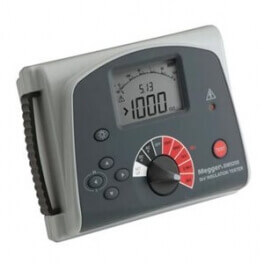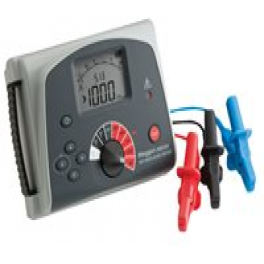BM5200 | Insulation Resistance Tester

- 1 T Ω, 1.4 mA, 5 kV digital insulation tester with digital and analogue display
- Five test ranges; 250 V, 500 V, 1000 V, 2500 V and 5000 V
- Insulation (InS), Polarization Index (PI) and variable timed test (t) modes
- Selectable DC or AC (including frequency) voltmeter functions
- Guard terminal to shunt surface leakage currents
- CATIII 600 V safety rating
The Megger BM5200 insulation resistance tester is a battery powered insulation tester with digital and analogue arc display. It has been designed for high voltage insulation resistance testing in the maintenance and servicing of cables, rotating plant machinery, transformers, switchgear, and industrial applications.
The unit performs DC insulation tests at 250 V, 500 V, 1000 V, 2500 V, and 5000 V and its insulation resistance measuring range is 100 k Ω to 1000 G Ω. It also provides automatic discharge for capacitive circuits under test as well as displaying the decaying voltage.
The BM5200 comes with a guard terminal which can be used to minimise the effects of surface leakage and hence erroneous measurements when carrying out insulation resistance tests.
Three insulation resistance (IR) test modes are provided (InS, PI, and t) and available in any IR test range. In insulation (InS) mode, tests are initiated by pressing and holding down the "TEST" button for two seconds and terminated by a second press of the "TEST" button. The Polarisation Index (PI) mode performs a ratio metric test that calculates the ratio of insulation resistance at ten minutes to insulation resistance at one minute. The IR test timer (t) mode facilitates a single fixed time test based on the set time interval 't'.
For capacitive test objects, the instrument will automatically discharge through an internal resistor and indicate voltage across the terminals in the range 25 V to 600 V with higher voltages indicated by ">600 V". This feature will give decaying voltage indication following the testing of reactive loads. When the voltage indicator disappears, it is safe for the user to disconnect the test leads. The instrument's safety features include high voltage warning indicator, external voltage display after IR test, automatic discharge of reactive loads, and test leads
